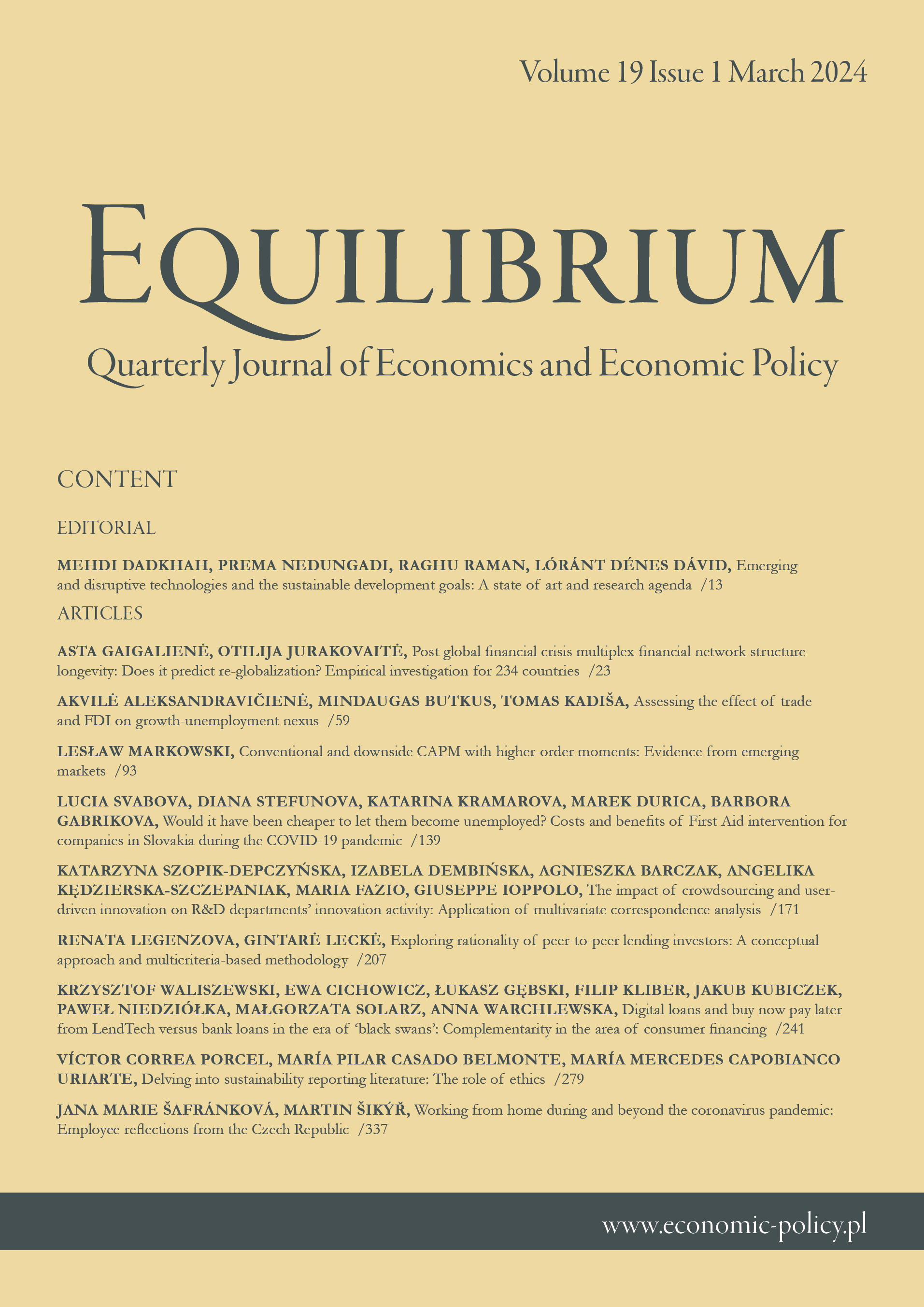企业违约——新的方法论方法和波兰的初步证据
IF 6.2
Q1 ECONOMICS
Equilibrium-Quarterly Journal of Economics and Economic Policy
Pub Date : 2017-12-31
DOI:10.24136/EQ.V12I4.39
引用次数: 8
摘要
研究背景:破产文献中充斥着大量的(计量经济学)模型,从奥特曼的Z-score、奥尔森的O-score、兹米耶夫斯基的probit模型到k近邻、分类树、支持向量机、数学规划、进化算法或神经网络,所有这些都旨在以最高精度预测财务困境。我们认为企业违约也是一个重要的研究课题,只能用预测的准确性来确定。尽管进行了大量的建模工作,但尚未提出统一的违约理论。文章目的:由于在违约的定义、违约的时间以及预测准确性的衡量方面存在分歧,各种模型的(预测能力)比较可能会产生严重误导。本文的目的是主张研究重点从最大限度地提高准确性转向分析预测因子的信息能力。通过这样做,我们可能更接近于理解违约本身。方法:我们对破产研究文献的方法论多样性和实证结果进行批判性评价。默认定义、采样程序、样本内和样本外测试以及精度测量都经过了仔细审查。在实证部分,我们使用了一个具有多周期预测范围的双随机泊松过程和一个约15000家波兰非上市公司的综合数据库来说明我们新的违约建模方法的优点。调查结果和附加值:在理论部分,我们呼吁建立一个统一的违约预测平台,为最大的企业数据集进行估计,以测试各种微观、微观和宏观信息来源的效用。我们的初步经验证据令人鼓舞。当t=0时,准确率为0.92,在违约前两年降至0.81。我们指出了公司流动性信息(或者在盈利能力方面)所起的关键作用,与奥特曼的传统相反,它对其他财务比率的预测能力几乎没有任何贡献。宏观数据被证明是至关重要的。它平均增加了超过10个百分点的准确率。未来,我们希望将上市公司和非上市公司的数据整合到一个模型中,最好是以比年度更高的频率,并包括公司竞争力地位的信息。本文章由计算机程序翻译,如有差异,请以英文原文为准。
Firm's default — new methodological approach and preliminary evidence from Poland
Research background: Bankruptcy literature is populated with scores of (econometric) models ranging from Altman’s Z-score, Ohlson’s O-score, Zmijewski’s probit model to k-nearest neighbors, classification trees, support vector machines, mathematical programming, evolutionary algorithms or neural networks, all designed to predict financial distress with highest precision. We believe corporate default is also an important research topic to be identified with the prediction accuracy only. Despite the wealth of modelling effort, a unified theory of default is yet to be proposed.
Purpose of the article: Due to the disagreement both on the definition and hence the timing of default, as well as on the measurement of prediction accuracy, the comparison (of predictive power) of various models can be seriously misleading. The purpose of the article is to argue for the shift in research focus from maximizing accuracy to the analysis of the information capacity of predictors. By doing this, we may yet come closer to understanding default itself.
Methods: We critically appraise the bankruptcy research literature for its methodological variety and empirical findings. Default definitions, sampling procedures, in and out-of-sample testing and accuracy measurement are all scrutinized. In an empirical part, we use a double stochastic Poisson process with multi-period prediction horizon and a comprehensive database of some 15,000 Polish non-listed companies to illustrate the merits of our new approach to default modelling.
Findings & Value added: In the theoretical part, we call for the construction of a single unified default forecasting platform estimated for the largest dataset of firms possible to allow testing the utility of various sources of micro, mezzo, and macro information. Our preliminary empirical evidence is encouraging. The accuracy ratio amounts to 0.92 for t = 0 and drops to 0.81 two years ahead of default. We point to the pivotal role played by the information on firm’s liquidity (alternatively in profitability) and — in contrast to Altman’s tradition — hardly any contribution to predictive power of other financial ratios. Macro data is shown to be critical. It adds, on average, more than 10 p.p. to accuracy ratio. In the future, we hope to integrate listed and non-listed firms data into one model, ideally at higher frequency than annual, and include the information on firm's competitiveness position.
求助全文
通过发布文献求助,成功后即可免费获取论文全文。
去求助
来源期刊
CiteScore
9.20
自引率
3.50%
发文量
28
审稿时长
36 weeks
期刊介绍:
Equilibrium. Quarterly Journal of Economics and Economic Policy is a scientific journal dedicated to economics, which is the result of close cooperation between the Instytut Badań Gospodarczych/Institute of Economic Research (Poland) and Polish Economic Society and leading European universities. The journal constitutes a platform for exchange of views of the scientific community, as well as reflects the current status and trends of world science and economy.
The journal especially welcome empirical articles making use of quantitative methods in: Macroeconomics and Monetary Economics, International Economics, Financial Economics and Banking, Public Economics, Business Economics, Labor and Demographic Economics, Economic Development, and Technological Change, and Growth.
Current most preferable topics and special issues:
The economics of artificial intelligence: business potentials and risks;
Digitalization and entrepreneurship in economics;
Sustainable socio-economic development, environmental and ecological economics;
Transition in the energy market (improving energy efficiency, alternative energy sources, renewable energy, energy security).

 求助内容:
求助内容: 应助结果提醒方式:
应助结果提醒方式:


